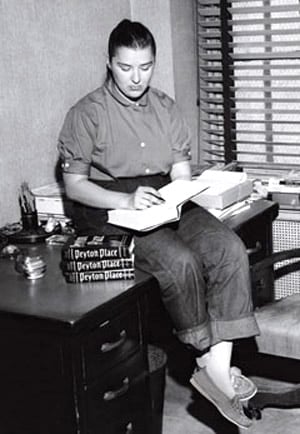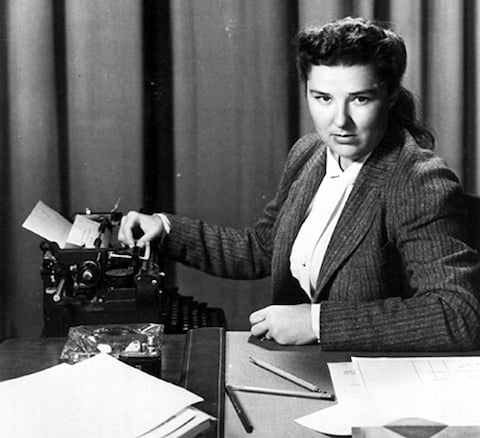Grace Metalious, Author of Peyton Place
By Regina Arbeia | On July 4, 2017 | Updated July 30, 2024 | Comments (4)

Grace Metalious (September 8, 1924 – February 25, 1964) was an American author best remembered for her sensational novel Peyton Place. It caused an incredible scandal when first published in 1956, but quickly one of the bestselling books of the twentieth century.
Of French-Canadian ancestry, she was born Marie Grace De Repentigny in Manchester, New Hampshire. Her parents separated when she was ten years old.
At the age of eighteen she married George Metalious (1925-2015) who came from a Greek family. The couple had three children. After World War II army service, George became a teacher, but Grace was far from the ideal 1950s wife, with her rebellious nature and burning ambition to write.
She didn’t care to conform to 1950s ideals
Grace freely admitted to being a lazy housewife. More comfortable in denim jeans and boxy shirts, she showed no interest in conforming to the 1950’s ideals of womanhood. Though she adored her children, she wouldn’t have won a Mom of the Year award; that said, no one holds men to any similar standard.
For Grace, writing was like breathing; she needed to do it to stay alive. Her husband resented her need to write and blatant nonconformity.
“I did not like being regarded as a freak because I spent time in front of a typewriter instead of a sink. And George did not like my not liking the things I was supposed to like.” After George returned home from the military he had an affair; Grace retaliated with an affair of her own.
. . . . . . . . . .
This may be the most iconic photo of the author
. . . . . . . . . .
Real-life inspiration for Peyton Place
It was while living in Gilmanton, New Hampshire, where George was a principal, that Grace read about a girl who murdered her father after his repeated sexual abuse. She hid him in their farm’s sheep pen, thus earning the case national headlines as “The Sheep Pen Murder.”
This was the seed of inspiration for one of the plot lines in this novel of the underbelly of small town life. She worked obsessively on The Tree and the Blossom, the novel that would be renamed Peyton Place by the astute New York editor who bought it.
When the book was published in the fall of 1956, the contents would blow the lid off uptight midcentury America. Critics denounced it as wicked, nasty and squalid.
The fact a young woman had dared to write frankly on topics like rape, murder, and abortion made the novel all the more shocking. Between the casual violence and racism, there were love scenes and secret trysts that were considered graphic for their time, but which are pretty tame by today’s standards.
Many libraries and book stores refused to stock Peyton Place, and it was banned in several countries, including Canada. Naturally, this made it even more popular. Well-thumbed copies were passed between friends; teenagers were eager to share its racy content. None of the shock or criticism kept it from becoming a huge bestseller.
Success for a book, the end of a marriage
The book’s massive success contributed to the deterioration of Grace’s marriage. It was a tough time for her children, who were taunted and shunned for their mother’s notoriety. Locals were outraged at what they perceived as having their dirty linen aired in public.
Grace made statements to interviewers like: “Everybody who lives in town knows that’s going on. There are no secrets, but they don’t want outsiders to know,” and “To a tourist these towns look as peaceful as a picture postcard, but if you go beneath that picture … all kinds of strange things crawl out.”
The relentless publicity and the glamorous lure of Hollywood added to the toll on Grace’s health and stability. She became dependent on alcohol and lived extravagantly, well beyond her means. A second marriage to her manager T.J. Martin foundered and she struggled with her sequel Return to Peyton Place (1959) which was reputedly finished by a ghost-writer.
The Tight White Collar (1960) and No Adam in Eden (1963) failed to have the same impact, though they have been the subjects of contemporary reconsideration.
. . . . . . . . . .

Two Original Reviews of Peyton Place
. . . . . . . . . .
Movie and television adaptations
The original movie Peyton Place (1957) starred Lana Turner and Hope Lange. A TV series Peyton Place ran from 1964 to 1969 and was the springboard for a number of actors including Ryan O’Neal and Mia Farrow. Return to Peyton Place (1961) was directed by Jose Ferrer and its stars included Jeff Chandler, Carol Lynley and Tuesday Weld.
Her novels are now being rediscovered in Women’s Studies courses in colleges and universities. Peyton Place is considered a major landmark in literature that reflects small town America in the World War II era. (The story begins in 1939, and not, as is widely believed, in the 1950s.)
In spite of a short-lived reconciliation with her first husband George, Grace continued on her destructive path. She began an affair with a British journalist, John Rees, and made a new will leaving him her whole estate shortly before she was rushed to hospital in Boston.
There, Grace Metalious died from cirrhosis of the liver on February 25, 1964. She was only thirty-nine years old. Her children subsequently successful challenged the will, but there was little left to distribute.
. . . . . . . . . .
Grace Metalious in an April 30, 1957 AP file photo
. . . . . . . . . .
The legacy of Peyton Place
For a thorough look at Grace Matalious’s fraught life and career, see this 2013 profile in New Hampshire Magazine, 50 Shades of Grace. This piece describes the lasting legacy of Peyton Place:
“A reporter once asked Grace if she thought Peyton Place would last. She said, ‘Oh no, I don’t think so.’ She was wrong. Time and significant changes in American social structure are placing Peyton Place in a new perspective. After more than 50 years the book is getting another look, and Grace is being seen as a woman who might have been ahead of her time.
Grace and her novels, including The Tight White Collar and No Adam In Eden, are part of women’s study programs in some pretty lofty universities.
Serious studies of Peyton Place are being published. The novel is taking its place as one in a pantheon of other novels about small-town life, such as Sinclair Lewis’s Main Street and Sherwood Anderson’s Winesburg, Ohio.
This biography was contributed by Regina Arbeia, who blogs at The History Bucket.
More about Grace Metalious
On this site
Major Works
- Peyton Place (1956)
- Return to Peyton Place (1959)
- The Tight White Collar (1961)
- No Adam in Eden (1963)
Biographies
- Inside Peyton Place: The Life of Grace Metalious by Emily Toth (2000)
- The Girl from Peyton Place by George Metalious and June O’Shea (1965)
More information
Articles, News, Etc.
- Peyton Place’s Real Victim
- What’s it Like Reading Peyton Place Today?
- Pandora in Blue Jeans: The Life of Grace Metalius
- 50 Shades of Grace
Film and Television adaptations


i first read Peyton Place as soon as it was published and available in pocket books here in Brazil. The first page where she describes Indian Summer is one of the most beautiful and poetic prose readings in my opinion. I saw the film too, but missed the series, as they were not shown here in Brazil.
The name Peyton Place was taken from another novel which also included incest along with medical marpractice to suit the desires of the local doctor. the name Peyton Place was given to a new estate development in the town. This novel is also about a small town.
Thank you for your comment, Magda. Grace Metalious really was a good writer; I think the sensational themes she wrote about made some readers overlook that fact.
I beg to differ. This beautiful woman of French-Canadian extraction is, and will always be, an absolute privilege to all who understand her. I love her dearly and I know for certain, for certain, I am not alone. In an old New England term, “How do you like them apples?”
What part do you disagree with? This is a pretty factual, objective post about Grace Metalious’s life and work. If you feel that there’s anything in error, please let us know!